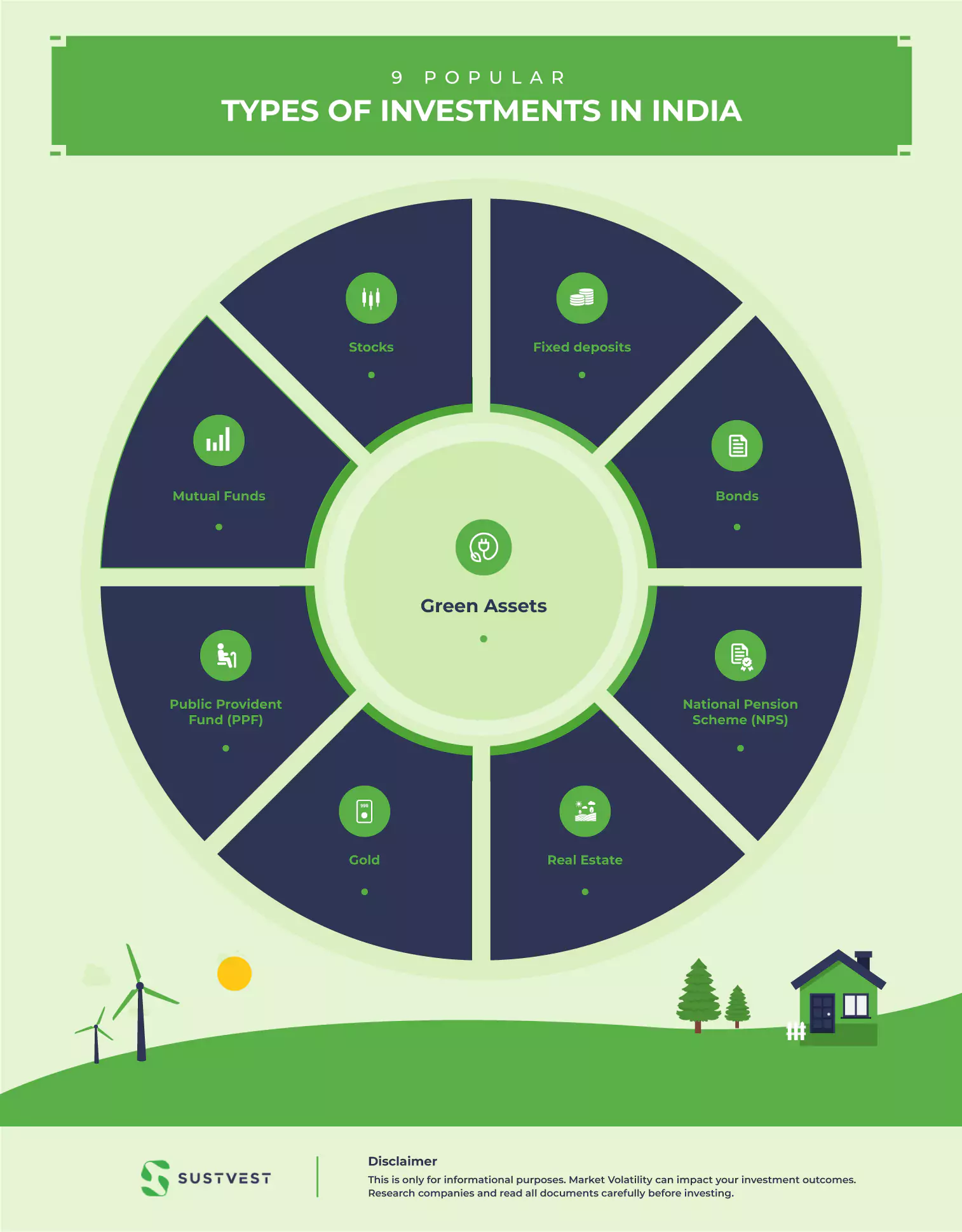Ever found yourself wondering, “Just how many types of investment options does India boast of?” The answer might just surprise you.
This vibrant nation isn’t just a cultural potpourri; it’s a financial one too! With an ever-evolving market, India presents a gamut of investment opportunities, some traditional and some as modern as tomorrow.
From the age-old allure of gold to the modern zeal of digital assets, there’s a world to explore.
Let’s embark on this exhilarating journey together, and by the end, you’ll not only know the count but also which one resonates with you the most.

What is an Investment?
An investment is the act of putting money into assets or ventures with the goal of generating profits or achieving specific objectives of investments.
The primary aim is to grow wealth over time, increase financial security, or reach certain financial targets. Investors carefully choose from various investment options, considering factors like risk tolerance, time horizon, and potential returns.
The objectives of investments can range from long-term wealth accumulation to funding retirement, education, or purchasing assets like real estate. Therefore, if you want to invest, you must know the basics of how to learn investment.
As you dive deeper into investments, consider exploring Investment – Function, Concept, And Everything You Need To Know. A holistic view awaits you!
9 Popular Types of Investments in India
Investments in India can be categorised based on risk, tenure, and taxability. The importance of investments lies in growing wealth, achieving financial goals, and securing the future.
Here are some popular types of Investment in India:
1. Stocks
Equity stocks are market-linked investments in India, available through IPOs and stock exchanges like NSE and BSE. Investing in individual stocks involves high risk but offers the potential for high returns.
Returns from stocks come in two ways where the stock’s value increases over time:
- Dividend declarations: Dividends are periodic payments made to shareholders by the company.
- Capital appreciation: Capital appreciation refers to the increase in the stock’s market price. It allows investors to sell stocks at a profit.
Investing in stocks of large-sized firms (blue chip or large-cap) typically offers stable capital value and substantial income through dividends.
In contrast, smaller firms (mid-cap and small-cap) are more likely to provide capital appreciation potential but may not offer significant dividend income.
2. Fixed deposits
Fixed deposits (FDs) are a popular investment option in India, offered by banks and financial institutions. They provide guaranteed returns with tenures ranging from 7 days to ten years, and interest rates typically range from 3% to 7%.
Senior citizens enjoy the additional interest in FD investments. The interest earned is higher than that of a savings account and can be paid out monthly, quarterly, half-yearly, annually, or at maturity.
Tax-saving FDs offer tax benefits under Section 80C, but the interest income is taxable based on the individual’s income tax slab rates. TDS is levied if the interest income exceeds INR 40,000 per annum (INR 50,000 for senior citizens).
3. Mutual Funds
Mutual funds are investment vehicles in India that pool money from different investors to invest in market-linked instruments like stocks and bonds. Depending on your financial goals, you can opt for equity funds, debt funds, or balanced funds.
A Systematic Investment Plan (SIP) allows you to invest small amounts regularly in MFs, making it a convenient and flexible option for investors.
Here are some of the common types of mutual fund investment options available in India:
- Equity Funds: These funds invest primarily in stocks of companies listed on stock exchanges. They aim for long-term capital appreciation and are suitable for investors with higher risk tolerance.
- Debt Funds: Debt funds invest in fixed-income securities like government bonds, corporate bonds, and money market instruments. They are relatively less risky compared to equity funds and are suitable for investors looking for regular income and capital preservation.
- Hybrid Funds: Also known as balanced funds, these invest in a mix of equity and debt instruments. They offer a balanced approach to risk and returns and are suitable for investors seeking a combination of capital appreciation and income.
- Liquid Funds: Liquid funds invest in short-term money market instruments and offer high liquidity. They are suitable for investors who want to park their surplus funds for the short term.
4. Bonds
Bonds are safe investment tools that pay a fixed interest rate to investors who lend money to the Government or companies. These borrowers raise funds for projects.
A bond has details like interest, maturity date, and terms. After the bond matures, investors get their money back. They can also sell the bond at higher prices before maturity in the secondary market to make profits.
Bonds are low-risk, but there’s a chance of default by issuers. Investors can check the bond’s credit rating to assess risk. Bonds with higher ratings are safer. Including bonds in an investment portfolio helps spread risk.
5. Public Provident Fund (PPF)
The Public Provident Fund (PPF) is a savings scheme offered by the National Savings Institute and some authorised banks in India. It is a low-risk investment backed by the Government of India, ensuring guaranteed returns.
The scheme has a lock-in period of 15 years, but investors can extend it in 5-year blocks if desired. PPF also offers tax benefits, making it attractive for tax savings.
Overall, PPF is a secure and tax-efficient option for those looking to grow their savings steadily over the long term.
6. National Pension Scheme (NPS)
The National Pension Scheme is a retirement scheme suitable for those who want regular income and tax savings after retirement. It’s a low-risk investment backed by the Central Government.
Investors can contribute at intervals during their employment and withdraw a percentage of the accumulated amount after retirement. The rest is given as a monthly pension.
NPS offers two types of accounts:
- Tier I (default)
- Tier II (voluntary)
Investments up to INR 1,50,000 in NPS qualify for tax benefits under Section 80C, and an additional INR 50,000 is eligible for tax deduction under Section 80CCD.
7. Gold
Gold has always been a favourite investment for Indians due to its emotional and social significance. People buy gold coins, bars, and jewellery on special occasions as a tradition.
Now, there are modern ways to invest in gold, like gold bonds and gold ETFs, which are gaining popularity. Gold is considered a hedge against market risks, protecting one’s portfolio. Although it doesn’t provide regular income like dividends, it’s a liquid asset and can offer returns that beat inflation.
So, investing in gold can be a smart move to safeguard your wealth and preserve its value over time.
8. Real Estate
Investing in real estate means buying, owning, and managing physical properties. They can be like land, buildings, and more. The main goal is to sell the property at a higher price later or earn regular rental income. It suits investors with long-term plans since property prices don’t change much in the short run.
Real estate investing in India has evolved with the rise of REITs or Real Estate Investment Trusts. This allows investors to own a fraction of properties with minimal investment.
REITs are instruments backed by real estate assets, offering shareholders a chance to earn regular dividends from rental income. It’s a lucrative option for steady income seekers in the real estate market.
Here is how you can invest in real estate:
- Research and analyse real estate market trends.
- Set clear investment objectives and budget.
- Consider different types of properties: residential, commercial, rental, etc.
- Decide on the location based on growth potential and demand.
- Obtain financing options if needed, like mortgages or loans.
- Conduct thorough due diligence on the property’s legal and financial aspects.
- Seek professional advice from real estate agents or consultants.
- Negotiate the purchase price and terms.
- Complete all legal paperwork and documentation.
- Manage the property or hire a property management company.
Before investing, do thorough research on market prices and verify all documents with legal experts to make a wise decision.
After mastering real estate investing, the next game-changer could be understanding How to Develop an Effective Investment Allocation Strategy. Dive into this to diversify and optimise.
8. Unit Linked Insurance Plans (ULIP)
Unit Linked Insurance Plans (ULIPs) in India offer tax benefits and serve as a unique investment and insurance tool. Paying the premium is divided into two parts: one provides a life cover, and the other is invested in market-linked funds.
ULIPs offer deductions under the Income Tax Act, making the premium paid eligible for tax deductions.
Additionally, the maturity benefits and long-term capital gains are tax-free, making ULIPs a tax-efficient investment option for individuals seeking insurance and potential market-linked returns.
9. Green Assets
In the wake of environmental consciousness, ‘Green Assets’ have emerged as the eco-warriors of the investment landscape.
Platforms like SustVest have pioneered the shift, offering intriguing opportunities from investing in rooftop solar projects to EV charging points. Not only do they represent a step towards sustainable living, but they also promise substantial returns.
As factories, schools, and residential complexes lean towards clean energy, these assets find increased adoption. Imagine this: your investment not only yields returns but also powers communities sustainably.
A win-win, isn’t it? Embrace Green Assets, and you’re not just investing in your future but also in a greener planet.

FAQs On How Many Type Of Investments
How can I start investing in India?
To begin investing in India, open a demat account with a registered broker, conduct thorough research, set financial goals, and diversify your portfolio wisely.
Are sustainable investments available in India?
Yes, sustainable investments have gained popularity in India, allowing investors to support environmentally responsible companies while seeking financial returns.
What is the risk level associated with different types of investments in India?
Risk levels vary across investments; stocks and cryptocurrencies carry higher risk, while bonds and fixed deposits offer more stability. Diversifying your portfolio can help mitigate risks.
Conclusion
India offers a diverse range of investment opportunities catering to various risk appetites and financial goals.
From traditional options like stocks, bonds, and real estate to modern alternatives such as cryptocurrencies and sustainable investments, the choices are abundant.
Arming yourself with a structured plan is always beneficial. Discover The 6-Step Investment Decision Process: A Blueprint for Smart Investing and make each move count.
To explore sustainable investment options in India and make informed choices for a greener future, consider SustVest—an innovative platform guiding you towards impactful investments. Now, seize the opportunity and discover how many types of investment India has to offer with SustVest.

Founder of Sustvest
Hardik completed his B.Tech from BITS Pilani. Keeping the current global scenario, the growth of renewable energy in mind, and people looking for investment opportunities in mind he founded SustVest ( formerly, Solar Grid X ) in 2018. This venture led him to achieve the ‘Emerging Fintech Talent of the Year in MENA region ‘ in October 2019.




